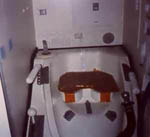




The waste management system on a spacecraft or space station does not operate in isolation. It is integrated into other systems associated with the environmental control and life support.
On Space Station 2020, as far as possible all waste is recycled. This is relatively easy with air, water and clothing, but garbage and sewage pose more of a problem. Both are potentially an infection hazard.
The
Air Recirculation System
Air on the Space Station needs to be circulated all the
time, otherwise it becomes stagnant and crew members can be asphyxiated.
Dust and microbe particles are removed by drawing the air through filters,
which are cleaned from time to time. Carbon dioxide is removed and
replaced by oxygen. Gases and vapors that are not normally present
in pure air are removed. These come industrial processes, cooking,
the crew and many other sources.
A far as the health of the crew are concerned, removal of microbial particles is very important. The filter are efficient enough that bacteria, fungal spores and even viruses are removed from circulation. Sampling of air quality is carried out regularly.
-
How
often is your garbage collected?
Once a week?
What happens if it is longer?
What would garbage be like after six months?
Bagging and sealing may be an answer, but what do we do about the gases? Completely seal the bag and it may burst because of the build up of gas pressure. Additionally, biological action of the type that occurs in garbage can produce heat, and this heat can be so great that it will spontaneously combust - catch fire. This can happen on the farm, to hayricks under some conditions, where damp hay, microbes and anaerobic conditions conspire together to create high temperatures. It is also possible to produce similar conditions in garbage.
On Space Station 2020 a minimum of rotting garbage is produced. Disposable food containers are always washed, dried, then exposed to ultraviolet before being bagged as inactive garbage. Active garbage, which emits gas, is placed in a container that allows gases to vent into the air conditioning system, where they are neutralized. Other garbage holders include wet containers that take toxic waste chemicals and bio-hazardous materials from the laboratories which cannot be reprocessed through the waste water system.
To see how it is done on the Shuttle visit: Housekeeping
The
Water Systems
What goes into the sewage on the Space Station?
- Feces
- Urine
- Washing water - personal
- clothes
- from food pep and consumption
- Waste effluent water from industrial, engineering and spacecraft systems facilities.
- Waste water from biomedical facilities
- Waste water from the hydroponics facilities

Toilet
on the Space Shuttle. © NASA, 1997
Processing
of Organic Waste
The Space Station has a means of recycling waste water from
washing and cleaning, and a sub-system for processing sewage waste.
This will work in a similar way to the sewage systems that are used in
most towns and cities. The Space Station system is more advanced.
It is smaller, completely automated, and operates in microgravity.
To understand how it might work on Space Station 2020, let us first understand
how a public utility treatment plant works on Earth.
Sewage treatment technology has been available for more than a hundred years, but it relies on supplies of oxygen, water and a gravitational field in order to work effectively. It also takes up large areas of land and produces volumes of waste - dry sludge - that even on Earth pose a problem.
So far, with all manned spacecraft and space stations, designers have been able to avoid designing a complete, recycling, sewage treatment system. Instead they rely on partial cleansing, by removal of unpleasant chemicals and organic contaminants - feces - from the water. These are rendered inactive (but not inert or "safe") and returned to Earth in suitable containers, for final processing and disposal. The waste water, however, is fully treated and recycled.
The removed waste consists both of fecal and other solids and water laden with high concentrations of various salts, which is referred to as "brine". These salts are difficult to process in space as they require a lot of energy to separate them from the water. The resulting residue still requires storage and disposal. Brine, and its possible solid residue is not easily recycled using current technology. By contrast, in a civic sewage system on Earth, the volumes of water passing through the system are so high that a brine problem does not occur. Here, the salts are in such low concentrations that they can pass through the system for discharge to the ocean, with no adverse effects. On a space station, however, the sewage is extremely highly concentrated, and the conventional system must be modified to cope with it.
Firstly, the entire system needs to be sealed. Gasses given off by the treatment system must not escape into the normal crew environment, and neither must liquids be allowed to contaminate clean water supplies. However, waste gasses from the treatment process must be piped away or the system will blow up! While carbon dioxide is unwanted it is already in need of re-processing through the spacecraft's air-conditioning system, and does not pose a hazard, just a small inconvenience. Methane, though, can be used as a means of power from its combustion, and on balance could be a useful commodity. The waste sludge from sewage is a plant nutrient and could be used to support a hydroponic plant-growing facility. However, there is likely to be more dry sludge than could be used by the facility, so what do you do with the remainder? The answer is probably that it must be bagged and sealed and returned to Earth. one of the tasks necessary when a cargo pod arrives will be shifting something close to 150 kg (approx 3330 lbs) of dried excrement to return to Earth.
One alternative for disposing of the waste is incineration, but this would release carbon dioxide, which would then need to be removed from the environment by other means.
Sewage systems also produce low-grade heat. On Earth, this is not easy to collect and utilize, but in a compact system on board our Space Station this can be used for minor secondary heating purposes.
In the future, however, it is likely that new technology with be used and one such system that offer promise is a system that uses a combination of filtration and Reverse Osmosis.
Despite this, it should be possible to make a sewage system that will recycle much of the waste material of the space station, and use some of the principles of the traditional sewage plant.
Drinking
water
Sewage processing is only half the story of recycling the
water on board the Space Station. As we saw with the civic sewage
system the output water is not recommended for drinking. Similarly
on the Space Station, sewage water that has been treated by having brine
and solids removed needs further treatment before it can be re-introduced
to the drinking water system - otherwise known as potable
water.
The best way to produce pure drinking water is by gathering condensation. Potable water system that are in operation on the Mir space station and International Space Station works by multifiltration and condensation. Water is formed from the atmospheric carbon dioxide reduction process. The water is passed through six filter beds which include active carbon and ion-exchange resin. These beds have a limited life before they become contaminated and they are changed by moving each bed up the cascade in turn. The first bed is removed and trashed when its efficiency fall below a certain safe level. Microbial growth is impeded by heating and chemically treating the process water. Iodine, a disinfectant, is injected by a microbial check valve.
Go
to
Home
| Space Station
| Mars | Rainforest
© 1999 Satellite Events Enterprises Inc.
